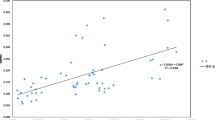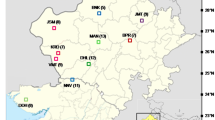Abstract
Argan Tree is well known for its precious oil extracted from its seeds particularly used for the nutritional and cosmetic benefits. Because of the high international demand, the argan tree suffers from overexploitation and its cultivation is rare. Thus, the assessment of the genetic variation of this endemic tree is critically important for designing conservation strategies. In the present study and for the first time, genetic diversity of the global natural distribution of argan tree (Argania spinosa L.) in Morocco was assessed. Four IRAP (inter-retrotransposon amplified polymorphism) primer combinations and seven ISSR (inter-simple sequence repeat) primers amplified 164 and 248 scorable polymorphic bands respectively. Polymorphic information content (PIC = 0.27), resolving power (Rp = 15) and marker index (MI = 10.81) generated by IRAP primer combinations were almost identical to those generated by ISSR primers (PIC = 0.27, Rp = 9.16 and MI = 12). AMOVA analysis showed that 49% of the genetic variation was partitioned within populations which is supported by Nei’s genetic differentiation (Gst = 0.5391) and the overall estimate of gene flow (Nm) being 0.4274. The STRUCTURE analysis, PCoA (principal coordinate analysis) and UPGMA (unweighted pair-group method with arithmetic mean) based on the combined data matrices of IRAP and ISSR divided the 240 argan genotypes into two groups. The strong differentiation observed might be due to the geographical distribution of argan tree. Our results provide crucial insight for genetic conservation programs of this genetic resource.



Similar content being viewed by others
References
Alavi-Kia SS, Mohammadi SA, Aharizad S, Moghaddam M (2008) Analysis of genetic diversity and phylogenetic relationships in Crocus genus of Iran using inter-retrotransposon amplified polymorphism. Biotechnol Biotechnol Equip 22:795–800
Alikhani L, Rahmani M-S, Shabanian N et al (2014) Genetic variability and structure of Quercus brantii assessed by ISSR, IRAP and SCoT markers. Gene 552:176–183
Bani-Aameur F, Ferradous A, Dupuis P (1999) Typology of fruits and stones of Argania spinosa (Sapotaceae). For Genet 6:213–219
Baraket G, Chatti K, Saddoud O et al (2009) Genetic analysis of Tunisian fig (Ficus carica L.) cultivars using amplified fragment length polymorphism (AFLP) markers. Sci Hortic 120:487–492
Chimi H, Cillard J, Cillard P (1994) Autoxydation de l’huile d’argan. Argania spinosa L. du Maroc. Sci Aliments 14:117–124
de Waroux YPL, Lambin EF (2012) Monitoring degradation in arid and semi-arid forests and woodlands: the case of the argan woodlands (Morocco). Appl Geogr 32:777–786
Ding G, Zhang D, Ding X et al (2008) Genetic variation and conservation of the endangered Chinese endemic herb Dendrobium officinale based on SRAP analysis. Plant Syst Evol 276:149–156
Dumolin-Lapègue S, Demesure B, Fineschi S et al (1997) Phylogeographic structure of white oaks throughout the European continent. Genetics 146:1475–1487
Earl DA, vonHoldt BM (2011) STRUCTURE HARVESTER: a website and program for visualizing STRUCTURE output and implementing the Evanno method. Conserv Genet Resour 4:359–361
Ehrig FR (1974) Die Arganie Charakter, Ökologie und wirtschaftliche Bedeutung eines Tertiärreliktes in Marokko. Petermanns Geogr Mitteilungen 118:117–125
El Mousadik A, Petit RJ (1996) High level of genetic differentiation for allelic richness among populations of the argan tree [Argania spinosa (L.) Skeels] endemic to Morocco. Theor Appl Genet 92:832–839
Evanno G, Regnaut S, Goudet J (2005) Detecting the number of clusters of individuals using the software structure: a simulation study. Mol Ecol 14:2611–2620
Fan F, Cui B, Zhang T et al (2013) LTR-retrotransposon activation, IRAP marker development and its potential in genetic diversity assessment of masson pine (Pinus massoniana). Tree Genet Genomes 10:213–222
Geert AV, Rossum FV, Triest L (2007) Genetic diversity in adult and seedling populations of Primula vulgaris in a fragmented agricultural landscape. Conserv Genet 9:845
Godwin ID, Aitken EA, Smith LW (1997) Application of inter simple sequence repeat (ISSR) markers to plant genetics. Electrophoresis 18:1524–1528
Gupta M, Chyi Y-S, Romero-Severson J, Owen JL (1994) Amplification of DNA markers from evolutionarily diverse genomes using single primers of simple-sequence repeats. Theor Appl Genet 89:998–1006
Hamrick JL, Godt MJW (1996) Conservation genetics of endemic plant species. In: Springer (ed) Conservation genetics, pp 281–304
HCEFLCD (2012) Actualisation du programme d’action national de lutte contre la désertification (PAD LCD). Adaptation aux spécifitézonale (High Commision for Water, Forests and Desertification Control)
Honnay O, Jacquemyn H, Bossuyt B, Hermy M (2005) Forest fragmentation effects on patch occupancy and population viability of herbaceous plant species. New Phytol 166:723–736
Kalendar R, Schulman AH (2006) IRAP and REMAP for retrotransposon-based genotyping and fingerprinting. Nat Protoc 1:2478–2484
Kalendar R, Grob T, Regina M et al (1999) IRAP and REMAP: two new retrotransposon-based DNA fingerprinting techniques. Theor Appl Genet 98:704–711
Khadivi-Khub A, Shabanian N, Alikhani L, Rahmani M-S (2015) Genotypic analysis and population structure of Lebanon oak with molecular markers. Tree Genet Genomes 11:102
Kremer A, Petit RJ, Ducousso A (2002) Biologie évolutive et diversité génétique des chênes sessile et pédonculé. Rev For Fr 54:111–130
Kumar A, Bennetzen JL (1999) Plant retrotransposons. Annu Rev Genet 33:479–532
Lind JF, Gailing O (2013) Genetic structure of Quercus rubra L. and Quercus ellipsoidalis E. J. Hill populations at gene-based EST-SSR and nuclear SSR markers. Tree Genet Genomes 9:707–722
Majourhat K, Jabbar Y, Hafidi A, Martínez-Gómez P (2008) Molecular characterization and genetic relationships among most common identified morphotypes of critically endangered rare Moroccan species Argania spinosa (Sapotaceae) using RAPD and SSR markers. Ann For Sci 65:805–805
Margules CR, Pressey RL (2000) Systematic conservation planning. Nature 405:243–253
Milligan BG, Leebens-Mack J, Strand AE (1994) Conservation genetics: beyond the maintenance of marker diversity. Mol Ecol 3:423–435
Mouhaddab J, Aabd NA, Achtak H et al (2015) Patterns of genetic diversity and structure at fine scale of an endangered Moroccan endemic tree (Argania spinosa L. Skeels) based on ISSR polymorphism. Not Bot Horti Agrobot Cluj Napoca 43:528–535
Pakhrou O, Medraoui L, Yatrib C et al (2016) Study of genetic diversity and differentiation of argan tree population (Argania spinosa L.) using AFLP markers. Aust J Crop Sci 10:990–999
Peakall R, Smouse PE (2006) Genalex 6: genetic analysis in Excel. Population genetic software for teaching and research. Mol Ecol Notes 6:288–295
Peakall R, Smouse PE (2012) GenAlEx 6.5: genetic analysis in Excel. Population genetic software for teaching and research–an update. Bioinform Oxf Engl 28:2537–2539
Pecina-Quintero V, Anaya-López JL, Núñez-Colín CA et al (2013) Assessing the genetic diversity of castor bean from Chiapas, México using SSR and AFLP markers. Ind Crops Prod 41:134–143
Powell W, Morgante M, Andre C et al (1996) The comparison of RFLP, RAPD, AFLP and SSR (microsatellite) markers for germplasm analysis. Mol Breed 2:225–238
Prendergast HDV, Walker CC (1992) The argan: multipurpose tree of Morocco. Curtiss Bot Mag 9:75–85
Prevost A, Wilkinson MJ (1999) A new system of comparing PCR primers applied to ISSR fingerprinting of potato cultivars. Theor Appl Genet 98:107–112
Pritchard JK, Stephens M, Donnelly P (2000) Inference of population structure using multilocus genotype data. Genetics 155:945–959
Reisch C, Poschlod P, Wingender R (2003) Genetic variation of Saxifraga paniculata Mill. (Saxifragaceae): molecular evidence for glacial relict endemism in central Europe. Biol J Linn Soc 80:11–21
Rodrigues L, van den Berg C, Póvoa O, Monteiro A (2013) Low genetic diversity and significant structuring in the endangered Mentha cervina populations and its implications for conservation. Biochem Syst Ecol 50:51–61
Rohlf FJ (2000) NTSYSpc: Numerical Taxonomy and Multivariate Analysis System. Version 2.11x. Exeter Software, Setauket, New York, USA. https://www.scienceopen.com/user/46921341-13cc-45b0-a9a0-8cbb0d5ff2c2/other-publications. Accessed 6 Sep 2016
Roldán-Ruiz I, Dendauw J, Bockstaele EV et al (2000) AFLP markers reveal high polymorphic rates in ryegrasses (Lolium spp.). Mol Breed 6:125–134
Scotti-Saintagne C, Mariette S, Porth I et al (2004) Genome scanning for interspecific differentiation between two closely related oak species [Quercus robur L. and Q. petraea (Matt.) Liebl.]. Genetics 168:1615–1626
Sorkheh K, Amirbakhtiar N, Ercisli S (2016) Potential Start Codon Targeted (SCoT) and Inter-retrotransposon Amplified Polymorphism (IRAP) markers for evaluation of genetic diversity and conservation of wild Pistacia species population. Biochem Genet 54:368–387
Souframanien J, Gopalakrishna T (2004) A comparative analysis of genetic diversity in blackgram genotypes using RAPD and ISSR markers. Theor Appl Genet 109:1687–1693
Vicente MJ, Segura F, Aguado M et al (2011) Genetic diversity of Astragalus nitidiflorus, a critically endangered endemic of SE Spain, and implications for its conservation. Biochem Syst Ecol 39:175–182
Wu K, Jones R, Danneberger L, Scolnik PA (1994) Detection of microsatellite polymorphisms without cloning. Nucleic Acids Res 22:3257–3258
Xia T, Meng L, Mao K et al (2008) Genetic variation in the Qinghai-Tibetan Plateau endemic and endangered conifer Cupressus gigantea, detected using RAPD and ISSR markers. Silvae Genet 57:85–92
Yatrib C, Belkadi B, Pakhrou O et al (2015) Assessment of genetic diversity of Argania spinosa L. growing in arid and semi-arid areas of Morocco as revealed by Inter-Simple Sequence Repeats. J Agric Sci Technol B 5:336–346
Yeh FC, Yang RC, Boyle TBJ, et al (1999) POPGENE, version 1.31. The User-Friendly Shareware for Population Genetic Analysis. Molecular Biology and Biotechnology Centre. University of Alberta
Zietkiewicz E, Rafalski A, Labuda D (1994) Genome fingerprinting by simple sequence repeat (SSR)-anchored polymerase chain reaction amplification. Genomics 20:176–183
Acknowledgements
This work was realized in the framework of conducting the project ArganBiogen and funded by Hassan II Academy of Science and Technology (Morocco) and The Ministry of Higher Education, Scientific Research and Professional Training of Morocco. Acknowledgment to Saad Ibn Souda-kouraichi, Abdelhamid El mousadik, Abderrahim Ferradous, Fouad Msanda and Cherkaoui El modafar members of ArganBiogen consortium.
Author information
Authors and Affiliations
Corresponding author
Rights and permissions
About this article
Cite this article
Pakhrou, O., Medraoui, L., Yatrib, C. et al. Assessment of genetic diversity and population structure of an endemic Moroccan tree (Argania spinosa L.) based in IRAP and ISSR markers and implications for conservation. Physiol Mol Biol Plants 23, 651–661 (2017). https://doi.org/10.1007/s12298-017-0446-7
Received:
Revised:
Accepted:
Published:
Issue Date:
DOI: https://doi.org/10.1007/s12298-017-0446-7




